HAD a wonderful time last evening. Dinner with old friends Niki and Larry, and John and Ann, and then I ruined my night’s sleep, faded while watching Curiosity Stream, a delightful piece on the life of Jack Benny, awoke on the couch at midnight, did some reading, a bit of scribbling, grabbed a few more hours of sleep as it was starting to get light out…
I did commit myself yesterday to writing something here today about the Sunday Phantom, so here I be, duly armed with a coffee pot, will try to ward off the brain fog.
The Sunday strip, as you may know, is generally where we pay homage to the fantasy tradition Lee Falk established in the Phantom universe. It’s never been a hard-and-fast rule, but for tales that require an extraordinary suspension of disbelief, we tend to spread out and tell them in the (comparatively) wide open spaces of Sunday art.
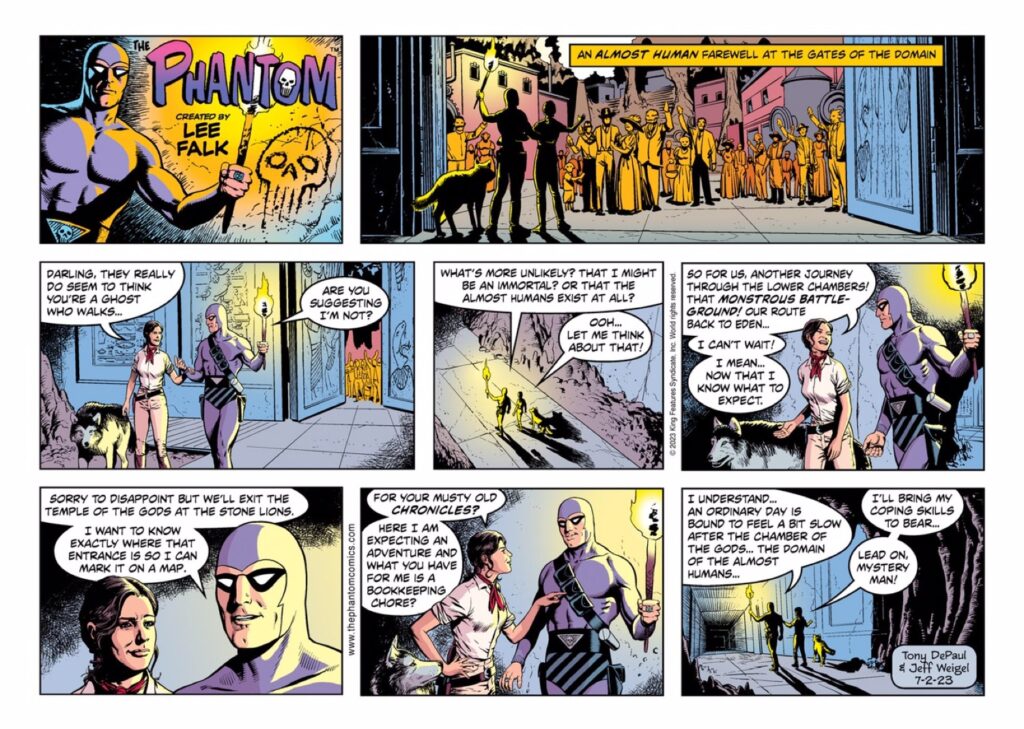
On the current Sunday yarn, Return to the Temple of the Gods, Jeff Weigel was working from a 126-page script, 423 panels. I couldn’t be happier with Jeff’s interpretation of the text. King Features is as lucky to have Jeff on the Sundays as it is to have the great Mike Manley on the Monday-through-Saturday narrative.
About the fantasy thing, here’s a case in point: Between 1956 and 1998, Lee Falk wrote a series of nine stories about a race of people who stand a foot high, dress as ancient Romans, are able to domesticate birds, put reins on them, fly around the jungle, a way-out fantasy element in the lore. And, yes, seven of Falk’s nine treatments of the Little People were published on Sundays.
In their 1956 debut, the little people topple the Phantom with drug-tipped spears and take him prisoner. Call it a homage to Jonathan Swift, or, depending on your point of view, a slow idea day.

I see this Return to the Temple of the Gods in the tradition of the little people; a bit of fantasy relief from the real-world issues of the daily strip, among them, crime, injustice.
In recent years, the daily strip has had something to say about this pernicious drift toward reactionary extremism around the world. That’s the mood, as we speak, if not the overriding context of the Phantom battling fascism at Gravelines Prison.
In both strips we examine the nature of the hero through his actions in the world; raise questions of the human condition, character, motive; whether fate, destiny, whatever you want to call it, might pursue a just end not only through the Phantom but supporting characters as well. That’s certainly going on at Gravelines.
Savarna Devi’s an antihero; her actions are all about Savarna Devi. Her methods and aims are unlike the Phantom’s. We wonder whether the Phantom, in ensuring Savarna’s freedom and survival, is his own man or an agent of something outside himself. Gravelines may lead him to his doom, but the journey, at its most elemental level, may not be about him at all. It may be about the path Savarna’s destined to walk in the world. The Phantom’s aware of that.
There’s a bit of that same dynamic going on in this Sunday yarn, albeit with a very different female counterpart.
There’s been a mystery woman in the background since day one, May 15, 2022. We didn’t see her face in the opening panels, we were never told her name. We presume she’s deceased by the strip’s second week, if only because the man traveling with her was mauled to death by a creature not unlike Babi, a bloodthirsty baboon-god worshiped in ancient Egypt.
Look closely and you’ll see its eyes peering from inside the cavern in panel 5, middle of the bottom row.
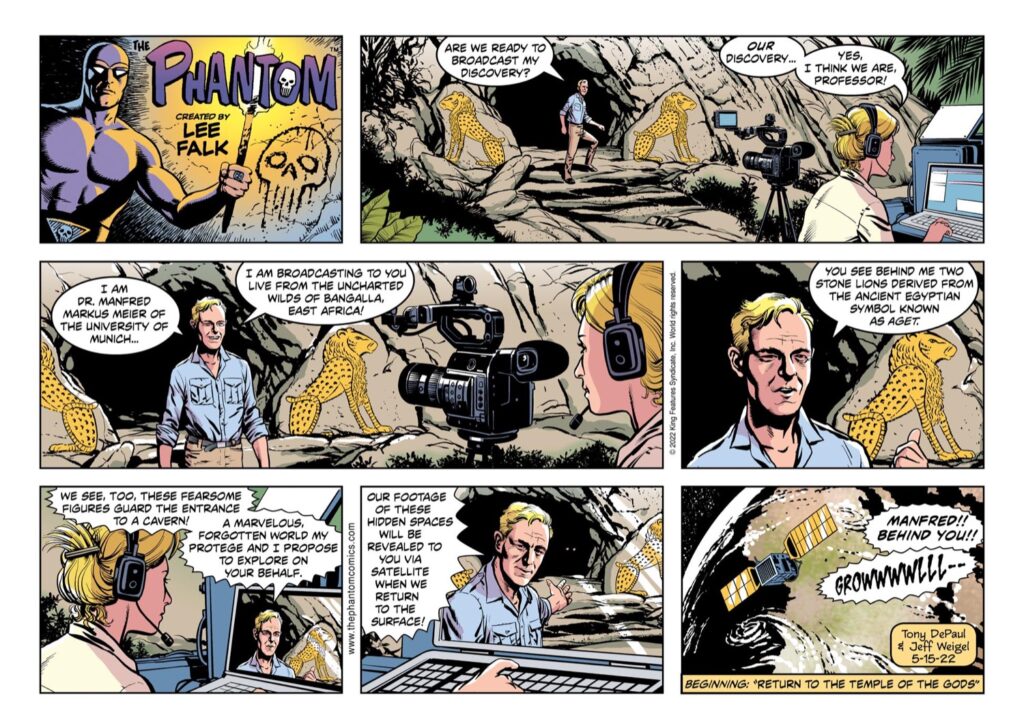
The Phantom captures a lion-like, half-human huntress of a species he’s just now encountered for the first time. She and her kind call themselves the Almost Humans but the Phantom won’t learn that for a while yet. The creature just growls at first and seems incapable of language.
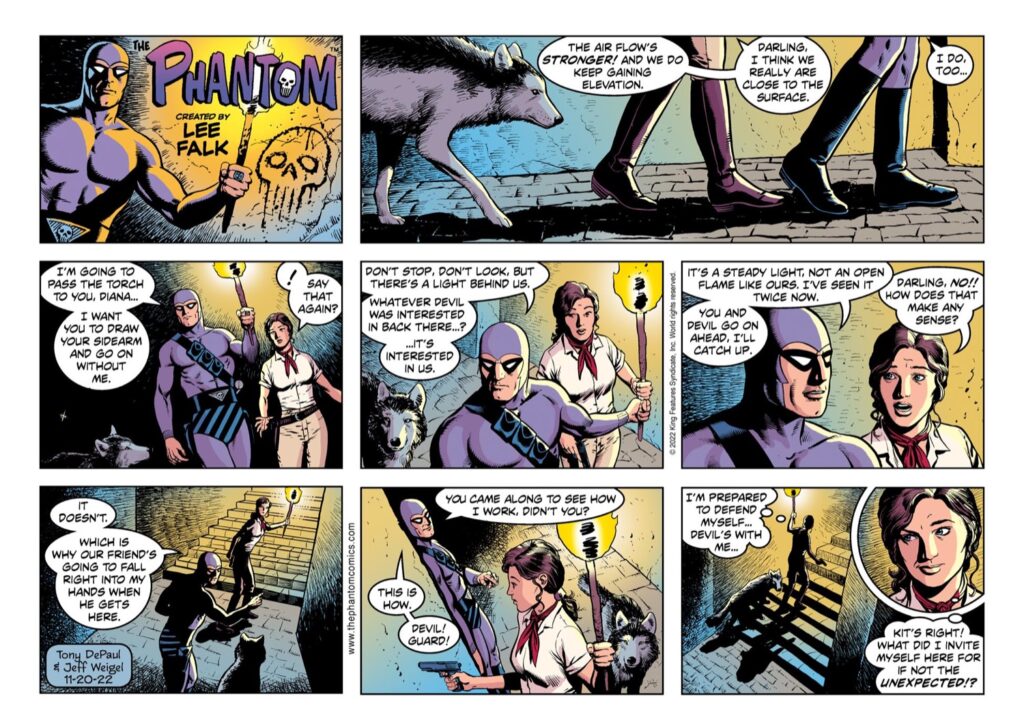
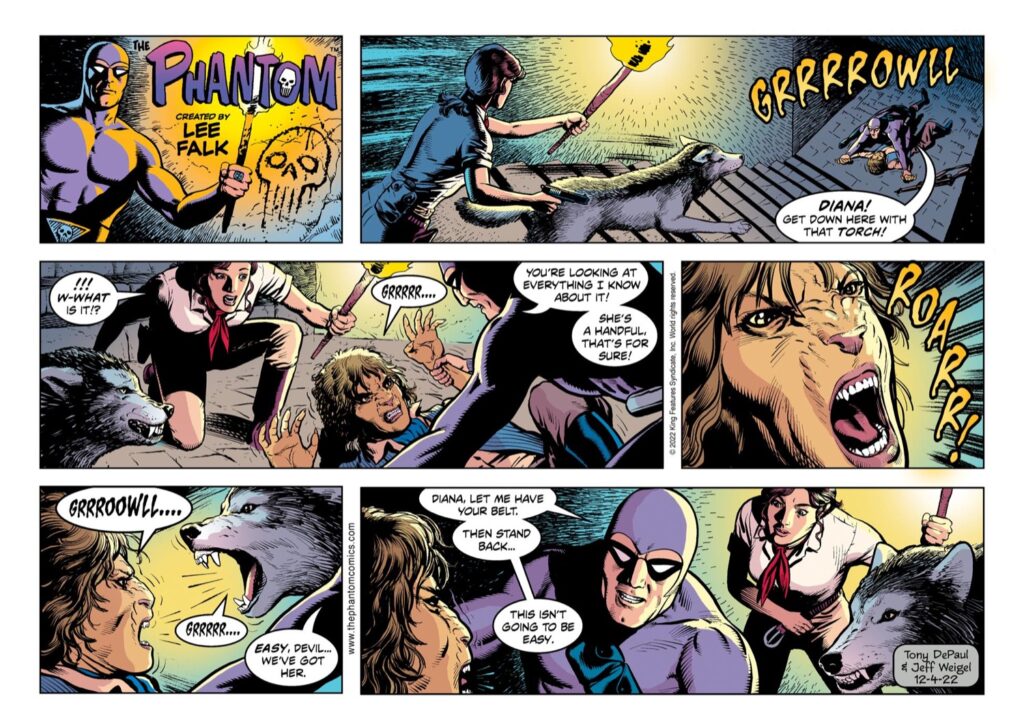
Still with me?
A year into the story, it turns out the mystery woman’s not only alive—we know her! She’s Mina Braun, a German explorer who was, for a time, the 21st Phantom’s adversary in a 2-part story we published in 2005, art by the late Paul Ryan.
Guran of the Bandar erased Mina’s memory of the Phantom, her memory of the Deep Woods, the temple, all that. The Phantom, in his Walker guise, delivered Mina safely home to Germany with her memory scrubbed clean. Or so he thought.
The Phantom tells the 2005 tale to Diana as they travel through spaces where the original adventure unfolded. Return to the Temple of the Gods, thus, is a story within a story.
I had no mercenary incentive in that, wasn’t carrying water for King Features, but I don’t mind taking advantage of this deep-continuity universe. I thought, if the story drives traffic to the web—readers who want to revisit the 2005 tale, those who want to read it there for the first time—all to the good. The lore of the last 87 years is an obvious asset in keeping the strip alive, though I can’t say I’m under the impression it might ultimately save the day. (I’ve said a thing or two about the lateness of the hour here.)
Now that this 62-week story’s just about fully published, it would be interesting to know how many readers get what it’s all about. Alas, there’s no mass feedback loop I’m aware of.
Social media has nothing to say worth knowing. It’s not a critique; it’s a tautology of self-selected voices crying I hate this, I hate that. I’m not in the least bit interested in anyone’s opinion on a story. What interests me is whether readers see it. Do they see what’s on the page?
Seeing implies that readers bring something of themselves to interpreting what they see: why a thing is as it is—why it must be as it is; how the text reveals character; how it opens some narrative pathways in the lore and forecloses others.
Most of our snarkers, I think, have never actually been fans of the strip. They sound more like habitues who would be delighted with nothing too awfully challenging, no real surprises. A new story every 18 weeks, each basically the same as the one before, only different. A predictable product. Same pizza but with the pepperoni arranged in a slightly different way.
The consumer-minded reader wants to see a straight through-line to the exit and wants to get there straight away.
Even the blokes at the Chronicle Chamber are a bit bumfuzzled at the duration of these tales, both daily and Sunday, but they’re real fans—true over-the-top fans—who reliably see things most readers likely miss. They hold forth on the daily and Sunday strips in this recent podcast, the daily strip for the first 15 minutes, Sunday for about 10 minutes after that.
Will back up here a bit, to the the start of the story:
Diana’s determined to see the Temple of the Gods for herself, but the Phantom tries to shake her by slipping out of their camp on the Isle of Eden.
He thinks Diana’s asleep—she’s just waiting for him to think that!
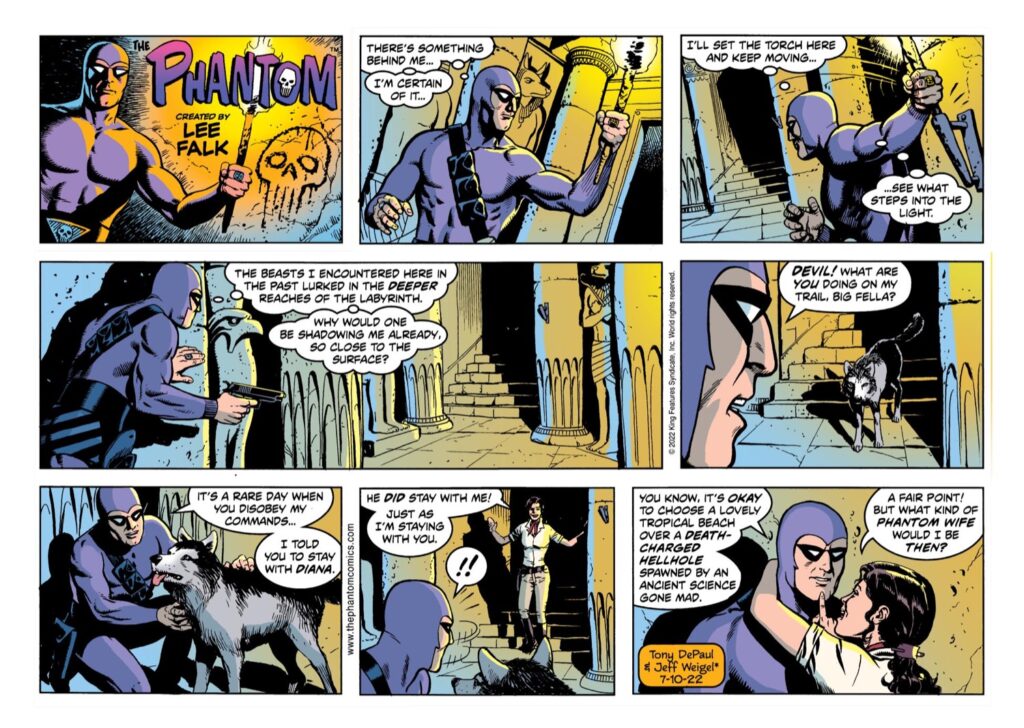
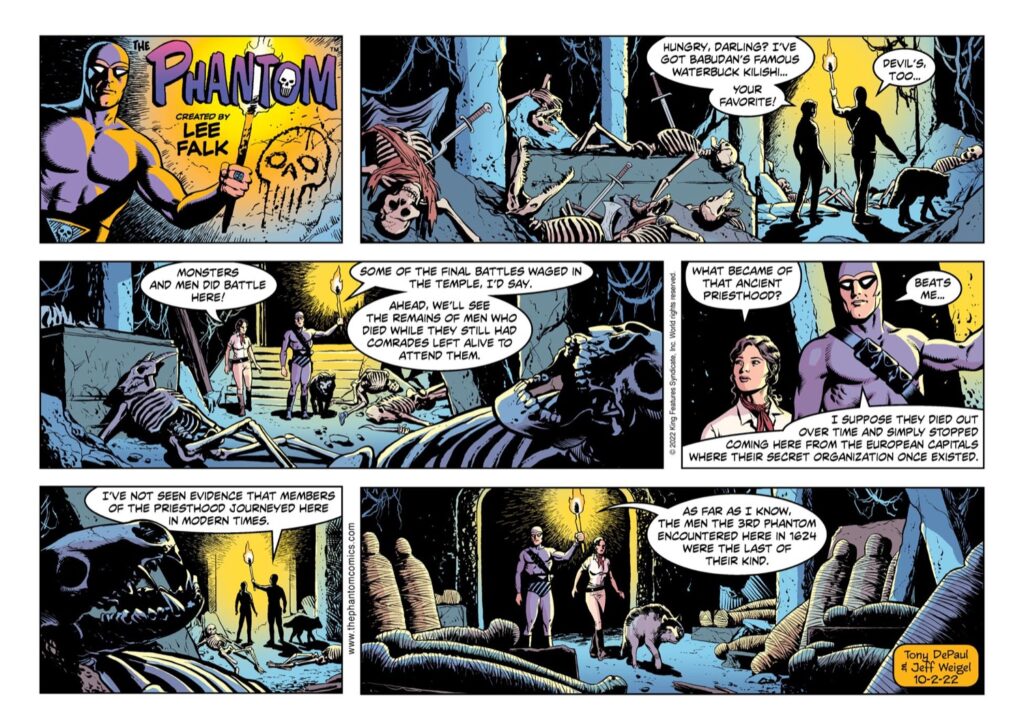
Notice all the Darlings? Another tip of the hat to Falk. Nobody calls their darling “darling” anymore. We’re just having fun here.
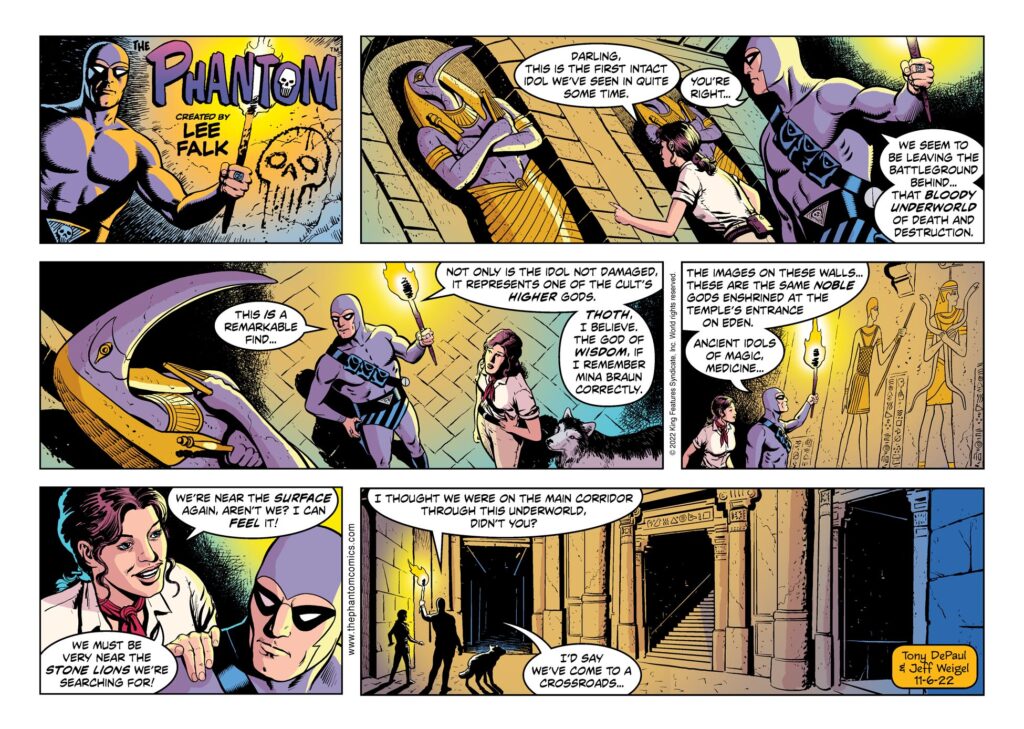
An aside on how this story came to be: In 2005, I inserted a few panels into the original Chamber of the Gods to give me a leg to stand on if I ever wanted to write again about Mina Braun. I was fairly certain I would.
Those panels had to do with this Bandar amnesia thing. You’ve seen that shopworn trick in everything from The Eternal Sunshine of the Spotless Mind to The Incredibles. It borders on a deus ex machina, a fix-all plot device that’s way too handy.
In 2005, I wanted to reserve the right to someday show the treatment having failed in Mina Braun’s case.
In September of that year, in the closing days of the original story, I cast the shadow of a doubt on the efficacy of the Bandar drug. It happened after Walker brought Mina home to Germany. There she takes note of the ring he wears.
Before Guran dosed her with the amnesia agent, Mina had seen the Ghost Who Walks wearing the ring. She knew his legend at that time, knew he was said to have walked the jungle for more than 400 years. Now she sees the ring, Walker says its more than 400 years old, this sparks a glimmer of recognition. It opens a pathway back to people and places Mina Braun was meant to forget.
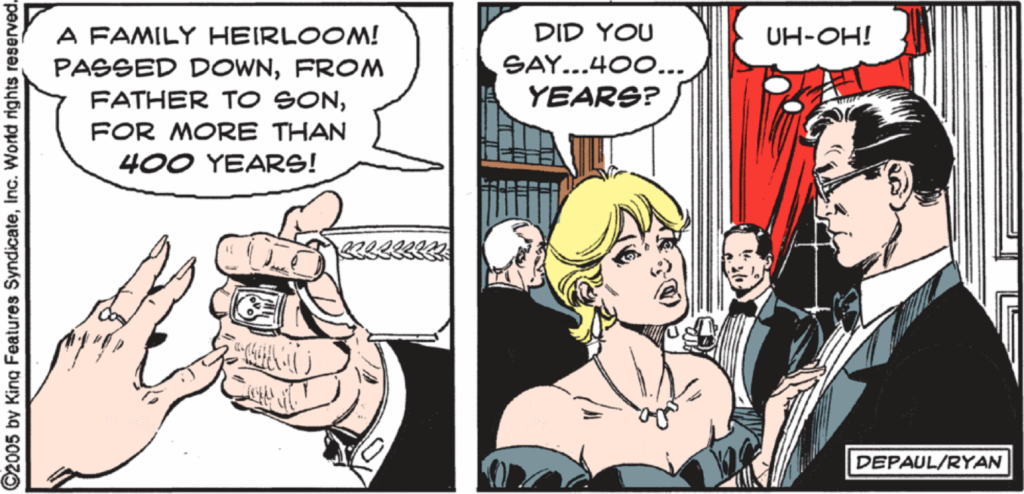

The Phantom thought he got away with it. In the 18 years since then, I’ll wager that no reader, anywhere, ever, thought otherwise.
My purpose was to end the story in a way that wouldn’t oblige me to bring back Mina Braun, but would provide the foundation you see before you should I ever enlist her as my reason for writing the amnesia drug out of the lore. Which now I have. You won’t see it used again in the KFS canon on my watch.
This 2005 thread carries forward into the strips that wrap up the tale:
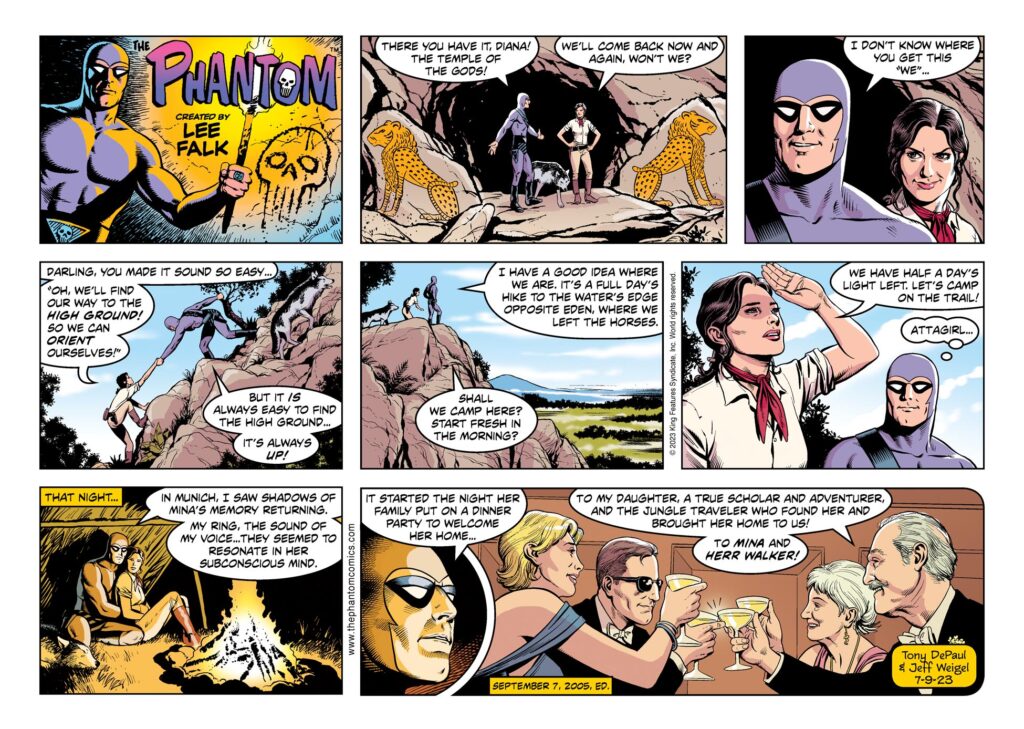
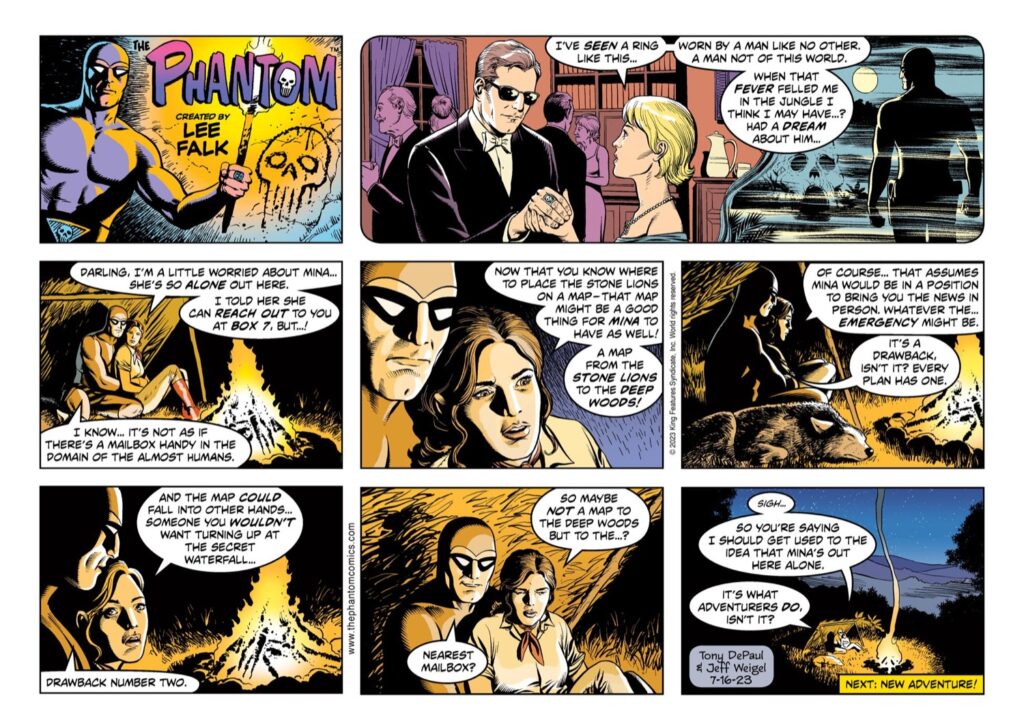
We back up here to last December, to the journey through the temple after Teydra’s capture.
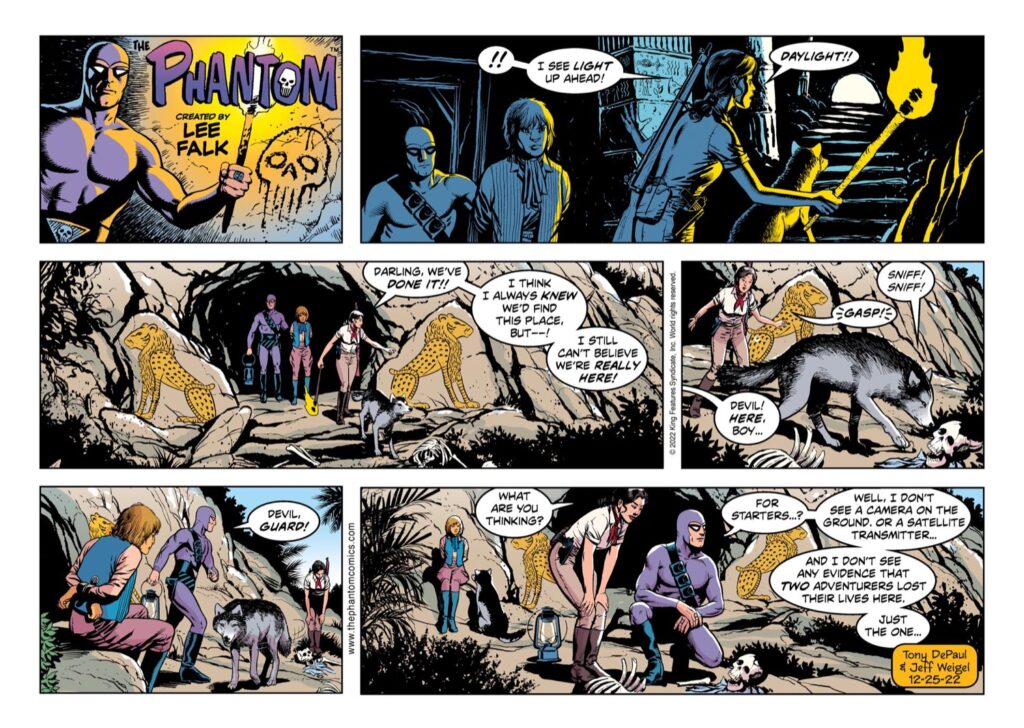
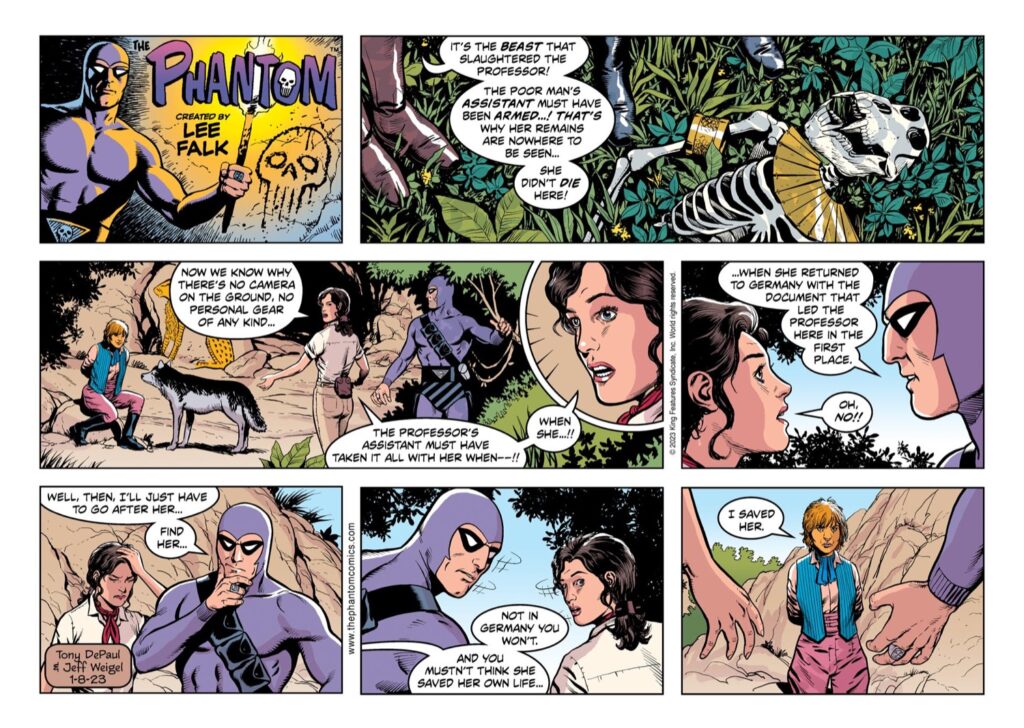
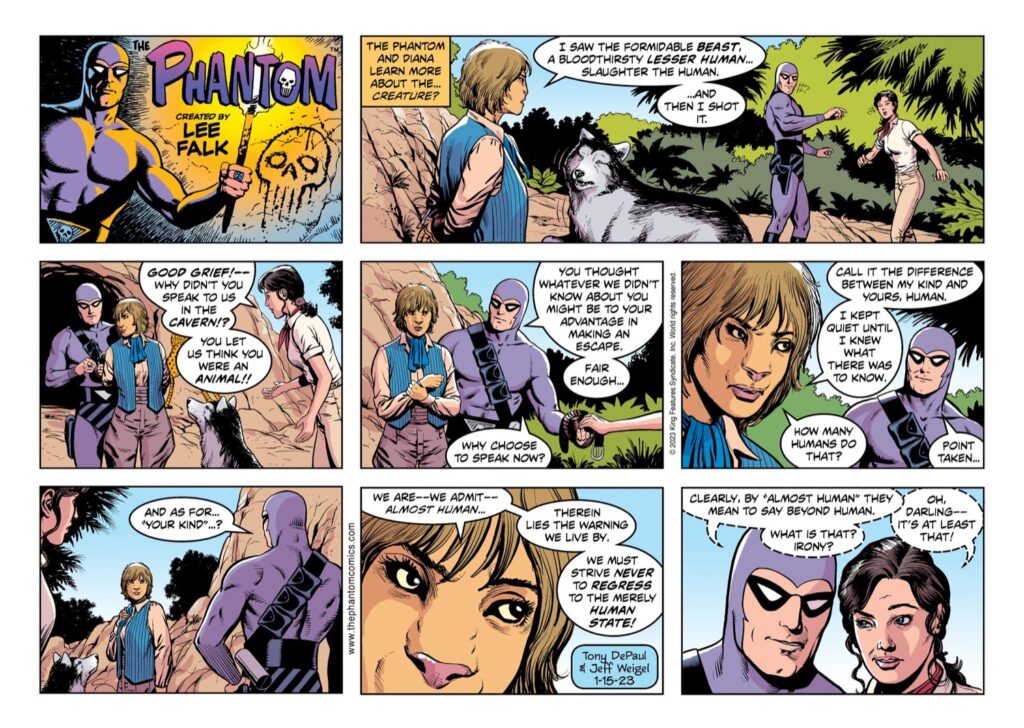
Naturally, the Phantom means to see for himself this subterranean region settled by the Almost Humans, and to take the unidentified woman out of there if he finds she’s being held against her will.
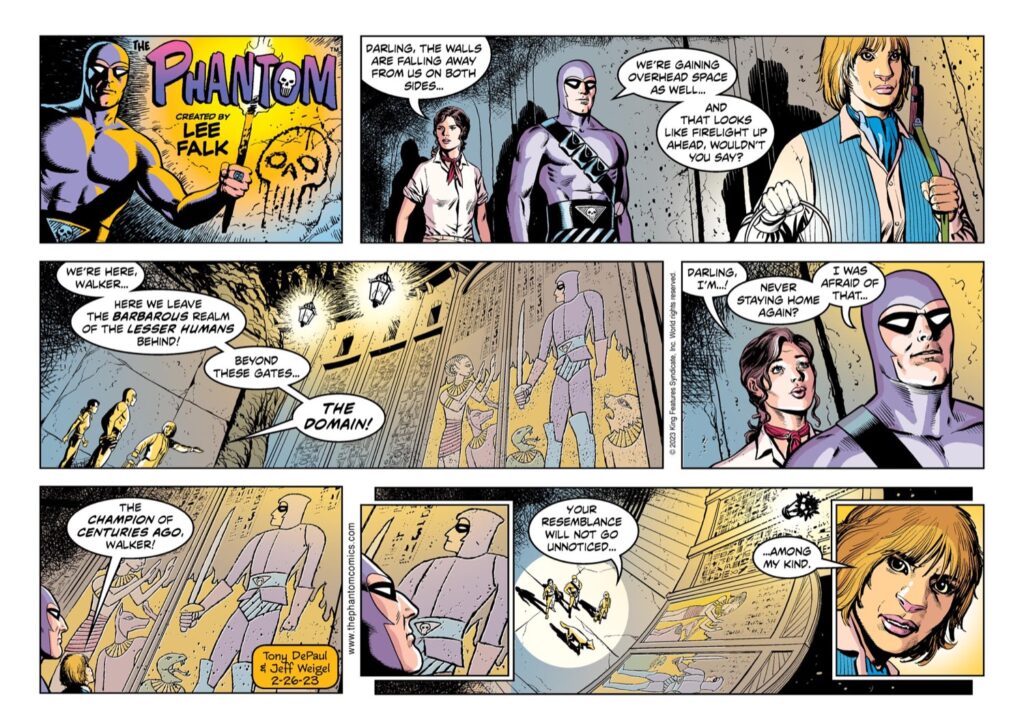
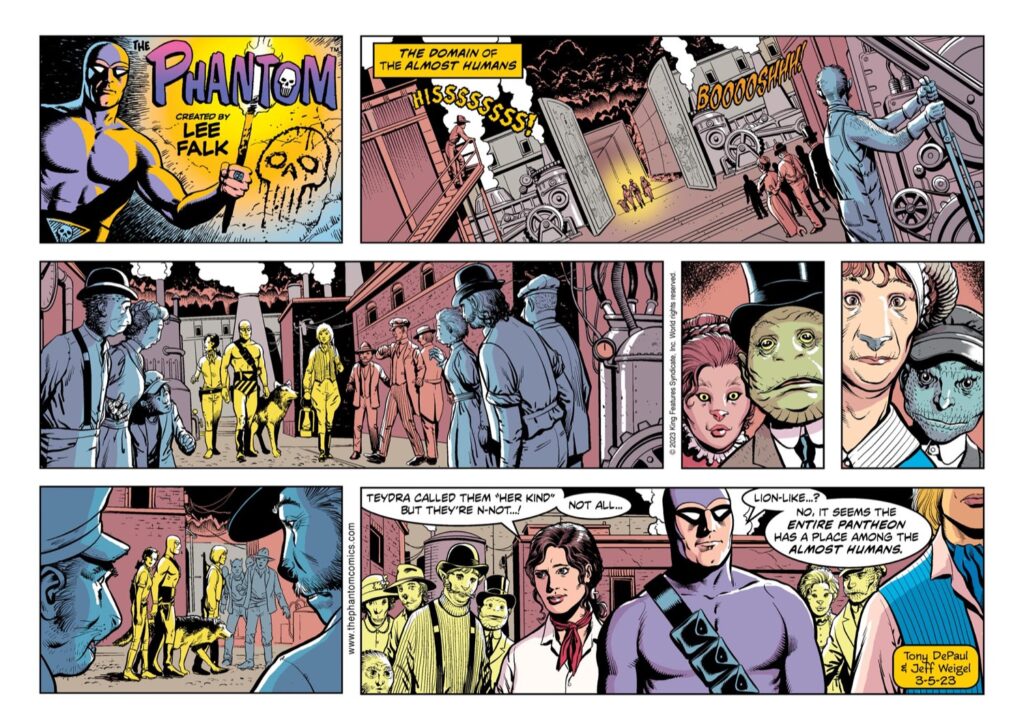
The Walkers are shown to the fanciest digs in town…
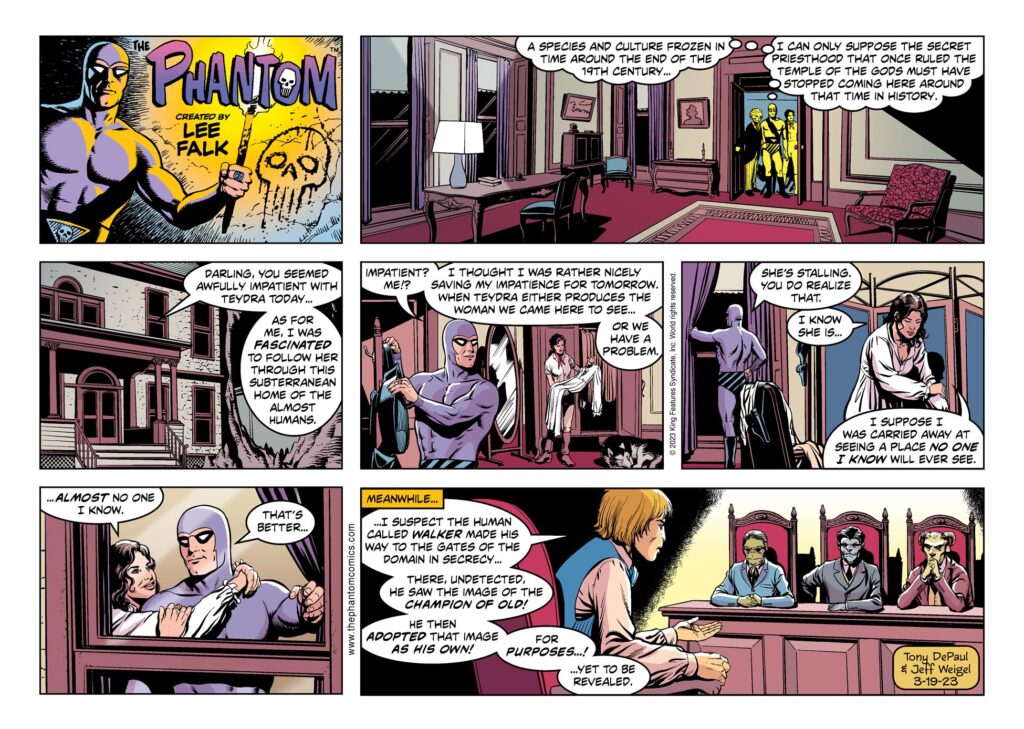
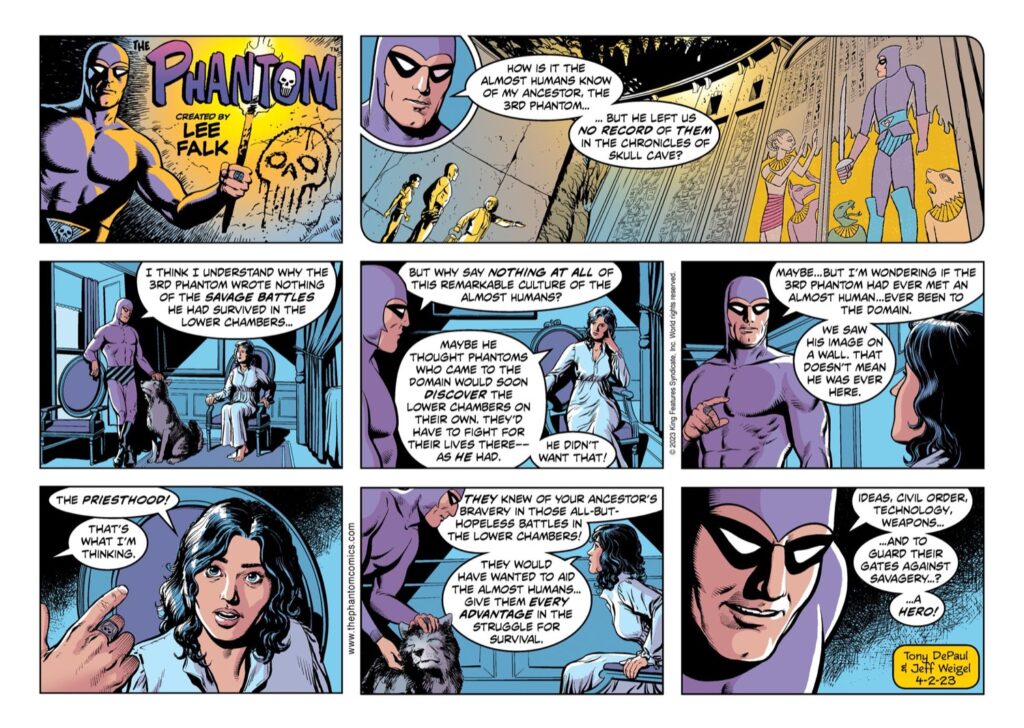
For me, part of the pleasure of narrative is the exercise of the off-text imagination. How might this story have progressed if Diana hadn’t anticipated the Phantom was planning to sideline her on Eden?
Let’s say he gets away with it and he’s free to undertake the subterranean journey alone. After he captures Teydra, it’s easy to imagine her choosing not to speak; choosing to reveal nothing of the nature of her species. If Diana’s not with the Phantom when he encounters Teydra, the creature hasn’t had an opportunity to inform her decision to speak. She hasn’t sized up her captor in the context of his running dialogue with Diana. She has no insight into his nature or his intentions.
The Phantom’s always on a discovery quest. Clearly, he discovers a whole lot less if Diana doesn’t accompany him on the mission. Yes, he almost certainly makes his way to the stone lions; but there he learns nothing of the mystery woman’s survival, nothing of the Domain, nothing of Mina Braun’s presence in the Domain.
Most of all, he never discovers that the Bandar amnesia drug can be dangerous. It failed in Mina’s case but he’ll never know it. He never learns that Mina returned to Bangalla in distress, under a disabling fear of descending into madness; a journey aimed at uncovering why she can’t stop dreaming of a mystery figure who shouldn’t exist.
The story thus turns on Diana knowing how the Phantom thinks. It’s about the Phantom and Diana in hidden spaces, the Walkers as husband and wife, adventurers, sleuths on the trail of a mystery. Together they build the legend, the lore, and make connections between then and now. They discern a continuing narrative over the sweep of centuries.
This story is unlike those Phantom tales you’ve seen where the big lug’s outwitted by nitwits, knocked on the head, tied up and thrown in the water. Will he slip his bonds and claw his way to the surface before his lungs burst for want of air? Well shit yeah he will, you’ve seen him do it a thousand times before, why would you think you’re not going to get your pepperoni this time?
As much as I admire and respect Lee Falk, I have no problem discarding those aspects of his legacy that belong in the dustbin. He himself was known to do exactly that.
He was a great concept man. He created this unique fictional universe I’m privileged to carry on in his stead, adding here, subtracting there, otherwise steady as she goes. At the same time, I’ve never seen any evidence the man walked on water. He was known to phone-in scripts on that same old hackneyed groove, casting the Phantom as Pauline in the Perils of. (Recall the Little People series I mentioned up top, how it begins with the Phantom rendered unconscious, tied up, helpless.)
This is running long, but just by way of illustration, here’s a snapshot of a notoriously bad writing job from 1942. Some Falk worshipers deny he wrote it. My understanding is that Falk’s on record claiming authorship of every story ever published under his name. If I’m wrong, I’m sure somebody will tell me.
Here’s how it opens…

(What I wouldn’t give for four big panels a day. Nowadays we have two small panels or three even smaller ones. No wonder even devoted readers have trouble following a thread until the strips have been gathered up on the aftermarket and published in a trade paperback.)
In this dreck from WWII, the Phantom’s woes begin when he’s stunned by a charged electric wire. His Japanese enemies tie him to a stake and mock-execute him with a dummy grenade. Then he’s trussed up in string and the string’s tied to the triggers of two rifles aimed point-blank at his head (one rifle’s not alarming enough, go for two). If he twitches he’ll pull the triggers and end his own life.
His foes pelt him with rocks trying to get him to twitch. Then he guesses this, too, must be a sadistic ploy, a mock execution, and the rifles are indeed found to be unloaded (one mock execution not alarming enough, go for two).
The Phantom’s slapped across the face with a bayonet and thrown into the path of an oncoming tank. Twice. (See narrative strategy on dummy grenades and unloaded rifles.)
As punishment for twice rolling out of the way of tanks, the Phantom’s pelted with bottles. Then he’s tied again to a stake and cast as the dummy in a round of bayonet practice, and then… and then…!
You get the idea.
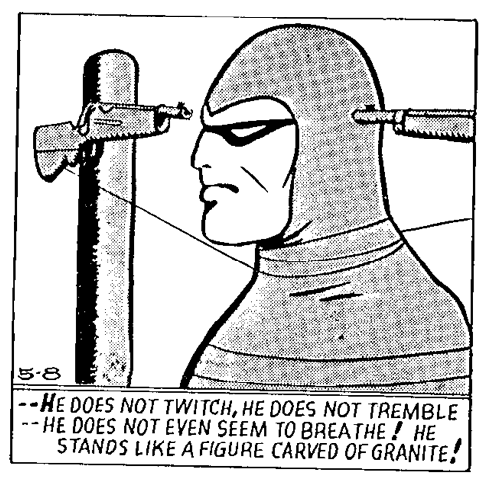
Or he stands like a figure, say… trapped in a story without a plot!
There are no stakes or ropes or wires in Return to the Temple of the Gods. No grenades, no tanks, no bayonets. No torment by rocks nor bottles.
In this story, the Phantom follows a trail to a woman who’s been unjustly discredited, driven from her profession, and now this mystery figure she’s seen in her mind’s eye turns out to be real. She hasn’t been haunted by fantastic dreams with no basis in reality. She never needed to hire herself out to a man who would take credit for her discoveries.
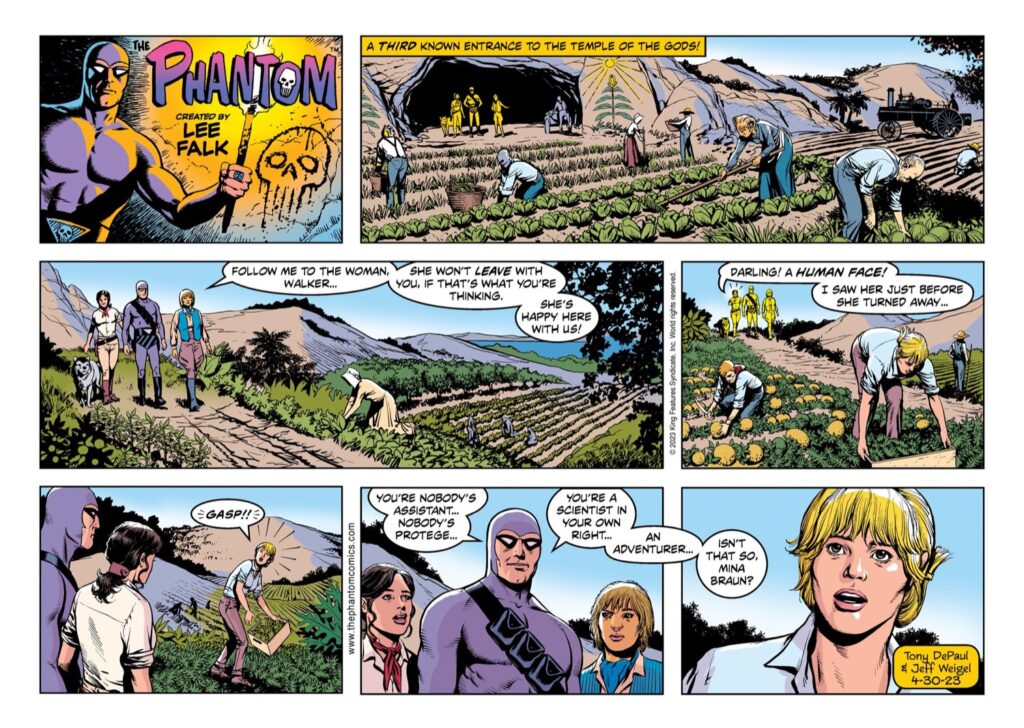
So by further exploring the Temple of the Gods in the execution of his oath, the Phantom rights a wrong. Tell me how that’s not the business he’s been in since 1936.
You can see more of these strips on that Chronicle Chamber podcast I mentioned. I lose the blokes from time to time but can recommend their site to you with no reservation. The lads have personality and great camaraderie.
I’ll close here with a word related to that little window of opportunity I left unlocked 18 years ago. Look for them if you like, I don’t think you’ll see them, but there are windows like that in this story, too. There are in most, actually.
If, one day, I want to revisit the Domain of the Almost Humans, Teydra the huntress, Mina Braun, revisit them in the Domain or anywhere else in the Phantom universe, I’ve left a few entry points hidden in this story. Some are in the scenario itself, others in a line of dialogue, or maybe tucked out of the way under a bit of subtext.
And then there’s one that I asked Jeff to show in plain sight, a strictly visual element calling no narrative attention to itself whatsoever.
I won’t tell you what or where these windows are, only that two of them appear in the handful of strips reproduced above.
Happy hunting, and cheers to all.
Thanks for reading.
Tony DePaul, July 2, 2023, Cranston, Rhode Island, USA


Some great background here – the opportunity to hear these thoughts from an author is one of the (admittedly mixed) benefits of social media. I hope Frew prints these stories complete in large publications (and in colour) as I’m interested to see how they read when collected. Still not used to reading one frame per day.
The negative view of the ‘Inexorables’ came a bit out of the blue but demonstrates how we all have different preferences. That story was reprinted in for the first time in decades in Australia around 1990 (I think) and seemed to have a lot of resonance with readers. Perhaps this was because many of us in this country grew up hearing about the horrors of WW2 from the generation that experienced it. The torture scenes struck a particular chord with me, as I’d grown up with tales of various relatives who had been subjected to various mistreatments/horrors by the Japanese army, and such discussions were still common in history classes (even at primary school). Australia, of course, had been attacked directly by the Imperial Japanese army. (In hindsight, it is remarkable how the memories were still so fresh, yet very few of us thought negatively of the Japanese people by that point).
I’m not a big fan of the overused ‘Phantom gets captured’ trope either…though I think Falk handles it pretty well overall, reflecting the approach/frequency taken by adventure stories over the years. Seem to recall the ‘Lone Ranger’ bible specified that the hero could only be captured for very short periods to avoid the ‘why don’t the bad guys unmask him?’ problem (which Falk sometimes addressed by using the ‘he who sees the Phantom’s face will die a horrible death’ legend).
The Fantomen stories are a more obvious example of how badly this can be handled. They constantly have the Phantom captured, often in circumstances he could easily have avoided (in some cases it is simply because he opts not to use his pistols). Even worse, it is common for others to save him, which takes away lot of his agency (at least IMO).
Must admit I haven’t warmed up to Savarna – I guess we’re not meant to. I can, however, picture her being a ‘breakout’ character if the Phantom ever gets adapted to the screen again.
Thanks for writing, Ross. I appreciate your thoughtful comments.
You’re of course right to say that an Australian reading of The Inexorables is properly seen in its historical context: attacks on Australian shipping, the bombings of civilians in Darwin and elsewhere, mistreatment (to say the least) of Australian POWs…
To say a bit more about that yarn: more than the poorly scripted action, it was the nature of the violence that colored my reading, the Phantom strangling enemies to death (April 8, 1942), drowning them (July 1, 1942). That’s very much at odds with my understanding of how the character behaves or might foreseeably be expected to behave even in a war scenario. That’s really what made me think that if Alfred Bester had ghosted anything for Falk in the war years, it had to be The Inexorables. (Anthony Tollin, I know now, has first-hand information suggesting otherwise.)
Violence in the strip is always at issue, of course. I’m told quite a number of readers object to the Phantom using his sidearms at Gravelines Prison in the current daily story; and objected to it in, for example, 2019’s Heloise Comes Home, the August 5 and August 7 strips. To my eye, those scenes were anything but gratuitous.
My feeling–I suspect you probably agree–is that if the character can’t use his sidearms to defend his life or the lives of others (other than that hokey old thing about shooting the gun, sparing the gunman), then he becomes ridiculous wearing a brace of sidearms. He’s playing dress-up at that point. It’s the Phantom at Phantom cosplay.
At the same time, I can’t ever imagine writing a scenario where he kills an enemy with his bare hands. I just don’t think that highly personal sort of violence is in him.
Thanks again for writing, Ross. Drop a comment here when the Dungeons Undone chapter wraps up and let me know what you think. I’ll likely post something about it at that time.
Lee Falk told me that a single PHANTOM storyline and two MANDRAKE stories were ghost-written by Alfred Bester, immediately before Lee was departing for WWII military service (which my late friend Alfie Bester also confirmed). Lee had thought he would need to have his strips ghost-written during his military service, but ended up being stationed in Washington, D.C., working for the Department of War Information, and discovered he had free time to continue writing both strips. It’s generally assumed by Phantom historians that Bester ghosted the 1944 Sunday storyline since it introduced “Kip Walker” as the Phantom’s real name and Lee despised “Kip” as a name, suggesting that he hadn’t written that story, and soon changed it to “Kit Walker.”
Interesting… I wasn’t aware of an Alfred Bester connection to 1944’s The Childhood of the Phantom. I was under the impression some were more inclined to see a ghostwriter’s hand behind the Phantom strangling enemies to death in 1942’s The Inexorables.
That thing about Falk being on record claiming authorship of all stories published under his name, I seem to think I read it in an interview transcript reprinted in Lee Falk – Storyteller, the volume published in Sweden in 2011. Unfortunately, the book’s 349 pages aren’t indexed. Without rereading it from the start I can’t cite the Lee Falk quote I remember (or misremember).
Thanks for the information, Anthony.
If this isn’t the Falk quote I remember, Anthony, it must be something like it. Covers the war years, in any event: “I was grateful to McCoy because I had joined the Army and had done all of (the Phantom) scripts ahead of time so I didn’t have to worry about that.”
It appears on page 291, in the transcript of an interview published around the time of the movie’s release in 1996.
Just wanted to say thanks for all of the “non-pizza” stories. Yours leave a lot of room for thought, which is one of the reasons I enjoy reading them. I like the not-entirely-Falk-but-still-Falk nature of this story, as well as the Crusaders’ Treasure story from the early 2000’s. Also, in this case, a story filled with a lot of very strong female characters, and one that gives Diana a meaningful role. You’ve done a great job of humanizing a man of mystery, while still giving him plenty of mystery.
Keep up the good work for as long as you can!
Thank you, Stephen. I have to credit Jeff for the Diana angle. He told me he’d like to draw a story where Diana accompanies the Phantom on an adventure. And I happen to know he loves to draw subterranean spaces (recall the incredible work he did on The Rat Must Die.) so I thought… I’ve got the perfect place… the Chamber of the Gods…
Thanks for the exposition, Tony. I could not place the significance of current Sunday saga. You weave a saga like no other. And I also thank Jeff for his creative interpretation.
Thank you, Joe. Jeff never fails; he’s been doing terrific work on the next Sunday story for months now. Yesterday I saw his rough pencils on the December 31 strip. Next week he’ll be working in 2024.
Well done my friend, you are indeed the master of the written word. I have been on the edge of my seat for the last 2 years, and you have given a very well done and thought out story in the daily and Sunday. It leaves all things there and open as well, so that events are covered in any way that you go, and beyond, and even with that, different time lines , a different universe or two, it can go many ways, with the legend still there. So who knows how things can go….. only The Shadow knows, and he ain’t talking
Thanks for following the strips, Terry. They really do need to be read in series. Day by day it’s tough, so easy for readers to lose their bearings. Reading two dozen days at a time isn’t a bad strategy for keeping track of things; for understanding why the focus moves from one venue to another and back again.
I have an unfair advantage in seeing it all at once, even just in script form. The Wrack and Ruin series will come in at seven chapters. Now that all the chapters are down on paper I have a mental map in my head of all 1,533 panels. That’s not something a reader can compile looking at two panels a day.
Curious about the name Mina Braun,
Is she somehow related to Eva Braun?
Haha… I wondered if anyone might catch that. Won’t say I’m surprised it was you, Dave.
That’s exactly where the surname came from. I hope they’re not related.
Dear Tony,
Always enjoy these long posts explaining your thought process behind the stories. I know many Phans look down upon Falk’s ‘fantasy’ stories so their opinion on this story would be interesting to know.
I am just fine with these. Little people is a favorite of mine so any chance of revisiting them?
Also waiting for Phantom to come to India (for an adventure and now for……….)
regards
Amir
New Delhi
Thanks for following the scribble, Amir. The little people tales made an impression on me when I was a kid opening up the Philadelphia Bulletin every afternoon to see what the Phantom was up to. I remember dreaming about little people after that.
Hello Mr DePaul. Just want to say, I’ve been reading your storylines in the Indian comic collection’s for quite some time now and really enjoyed it. Always look forward your stories.
My favourite as of now is Death stalks the 12th Phantom.
The Terry Beatty story from the winter of 2013-14? That was the 5th Phantom! I like that story, too. Terry could do anything. It was a pleasure working with him.
Mr Beatty’s art was really good and yeah, it was the 5th Phantom, thanks for the correction.
In this era of transgenderism, I find the concept of transhumanism not just disturbing but also frighteningly close to reality. Genetic modification of a human with animal species chromosomal matter sounds like science fiction; however, in the attempt to extend human longevity, we have men of ‘science’ already tampering with the human genetic code.
The idea that the ‘almost humans’ could be a result of such experimentation leads to an acceptance of the idea that such tinkering with what God hath wrought not being a bad thing.
I loved the adventure, while strongly disliking the premise upon which it was based.
When I wrote the original story in 2005 I never would have guessed where the science would be today. Lately I’ve read a few hair-raising accounts of biotechnologies virtually in our grasp.
So glad for your in-depth explanation. The idea that Guran and Kit even tried to erase the memory of this young woman was appalling…they’re the villains here. So glad he rectified in part this evil they’d done to her, and he wouldn’t have but for the inquiries of Diana.
But we’re left wondering if Mina will have a personal life, if she will be able to marry and have children, if she will get intellectual stimulation working in isolation, if she will be able to visit the surface world.
And the monsters, have they a social order? Were they also developed by the Germans?
This arc reinforced, to me at least, that Kit is basically a jerk. It’s the oath and Diana that prevent him from being a villain.
Thanks so much for this story.
Interesting point of view. Thanks for writing.
The secrets of the temple predate the life of the Germanic warrior Arminius, but yes, his Kriegsmarine descendants, so to speak, were scouting around to rediscover what they could, with Mina’s grandfather in command.